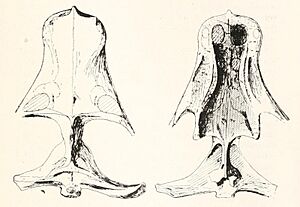Sidney H. Haughton facts for kids
Quick facts for kids
Sidney H. Haughton
|
|
|---|---|
| Born |
Sidney Henry Haughton
7 May 1888 Bethnal Green, Middlesex, England
|
| Died | 24 May 1982 (aged 94) |
| Occupation | Paleontologist |
| Years active | 1936—1964 |
Sidney Henry Haughton was a very important scientist. He was born in England in 1888 but became a famous South African paleontologist and geologist. A paleontologist studies ancient life, like fossils and dinosaurs. A geologist studies rocks and the Earth's history.
Haughton is best known for two big things. First, he described a type of long-necked dinosaur called Melanorosaurus in 1924. Second, he did a lot of work on the geology of the Witwatersrand area in South Africa. This area is famous for its gold.
Early Life and War Service
Sidney Haughton was born on May 7, 1888, in Bethnal Green, London, England. He was the oldest of three children in his family.
When World War I started, Haughton joined the Royal Army Medical Corps. This group helped soldiers who were sick or hurt. He was sent to places like Egypt and India. While serving, he got sick with malaria, which is a disease spread by mosquitoes. Because of his illness, he had to leave the army.
A Respected Scientist
Sidney Haughton became a Fellow of the Royal Society in 1961. This is a very special honor for scientists in the United Kingdom. It means he was recognized as one of the best in his field.
People who nominated him for this honor said he was the most important person studying the geology of South Africa. They praised his many contributions to understanding the rocks and ancient life of southern and central Africa. He was especially good at studying fossils, including ancient reptiles, fish, and mammals.
Important Discoveries
Haughton spent a lot of time studying the ancient reptiles found in the Karoo Supergroup in South Africa. He wrote many scientific papers about these amazing fossils. He also helped organize geological studies across all of Africa south of the Sahara Desert.
One of his most important works was published in 1964. It was a collection of 18 papers about the gold deposits in the Witwatersrand Basin. This book, called Gold Deposits of the Witwatersrand Basin, helped people understand how and where gold formed in that area.
Gallery




